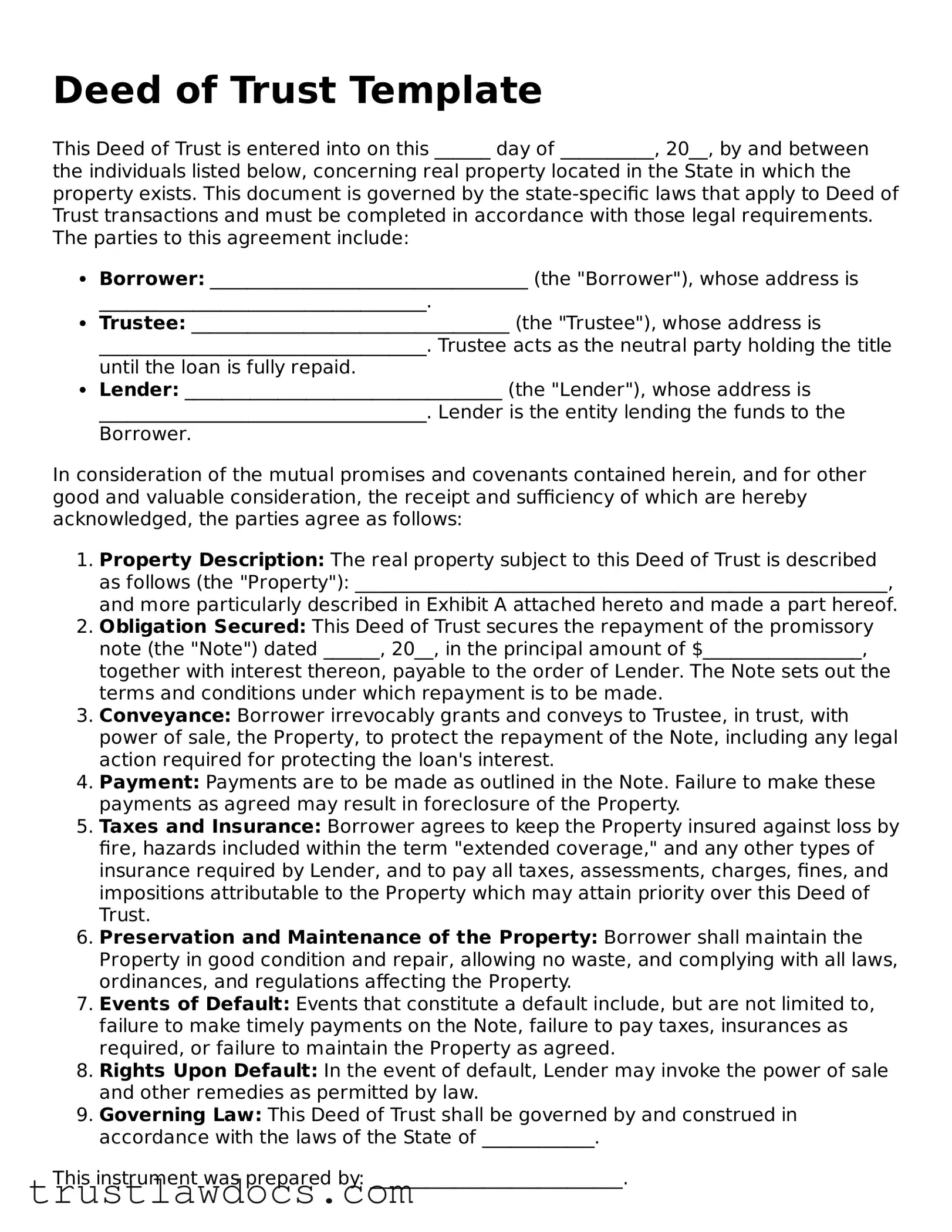Deed of Trust Template
This Deed of Trust is entered into on this ______ day of __________, 20__, by and between the individuals listed below, concerning real property located in the State in which the property exists. This document is governed by the state-specific laws that apply to Deed of Trust transactions and must be completed in accordance with those legal requirements. The parties to this agreement include:
- Borrower: __________________________________ (the "Borrower"), whose address is ___________________________________.
- Trustee: __________________________________ (the "Trustee"), whose address is ___________________________________. Trustee acts as the neutral party holding the title until the loan is fully repaid.
- Lender: __________________________________ (the "Lender"), whose address is ___________________________________. Lender is the entity lending the funds to the Borrower.
In consideration of the mutual promises and covenants contained herein, and for other good and valuable consideration, the receipt and sufficiency of which are hereby acknowledged, the parties agree as follows:
- Property Description: The real property subject to this Deed of Trust is described as follows (the "Property"): _________________________________________________________, and more particularly described in Exhibit A attached hereto and made a part hereof.
- Obligation Secured: This Deed of Trust secures the repayment of the promissory note (the "Note") dated ______, 20__, in the principal amount of $_________________, together with interest thereon, payable to the order of Lender. The Note sets out the terms and conditions under which repayment is to be made.
- Conveyance: Borrower irrevocably grants and conveys to Trustee, in trust, with power of sale, the Property, to protect the repayment of the Note, including any legal action required for protecting the loan's interest.
- Payment: Payments are to be made as outlined in the Note. Failure to make these payments as agreed may result in foreclosure of the Property.
- Taxes and Insurance: Borrower agrees to keep the Property insured against loss by fire, hazards included within the term "extended coverage," and any other types of insurance required by Lender, and to pay all taxes, assessments, charges, fines, and impositions attributable to the Property which may attain priority over this Deed of Trust.
- Preservation and Maintenance of the Property: Borrower shall maintain the Property in good condition and repair, allowing no waste, and complying with all laws, ordinances, and regulations affecting the Property.
- Events of Default: Events that constitute a default include, but are not limited to, failure to make timely payments on the Note, failure to pay taxes, insurances as required, or failure to maintain the Property as agreed.
- Rights Upon Default: In the event of default, Lender may invoke the power of sale and other remedies as permitted by law.
- Governing Law: This Deed of Trust shall be governed by and construed in accordance with the laws of the State of ____________.
This instrument was prepared by: ___________________________.
IN WITNESS WHEREOF, the parties have executed this Deed of Trust on the date first written above.
__________________________________
Borrower Signature
__________________________________
Trustee Signature
__________________________________
Lender Signature
State of ________________
County of _______________
On this ______ day of __________, 20__, before me, _____________________, a notary public, personally appeared ____________________________________________, known to me (or satisfactorily proven) to be the person(s) whose name(s) is/are subscribed to the within instrument and acknowledged that they executed the same for the purposes therein contained.
IN WITNESS WHEREOF, I hereunto set my hand and official seal.
__________________________________
Notary Public
My Commission Expires: __________
